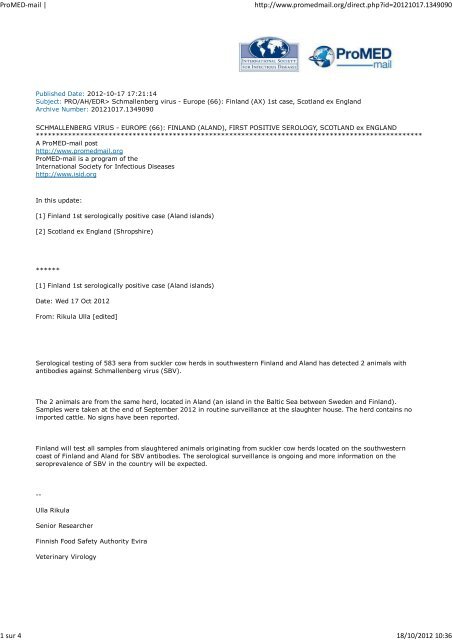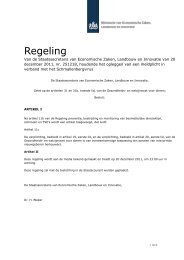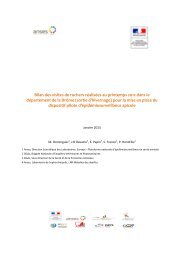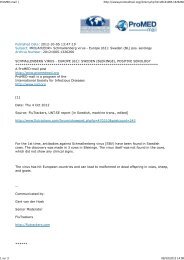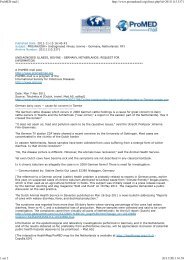ProMED‐mail | h p://www.promedmail.org/direct.php?id ...
ProMED‐mail | h p://www.promedmail.org/direct.php?id ...
ProMED‐mail | h p://www.promedmail.org/direct.php?id ...
Create successful ePaper yourself
Turn your PDF publications into a flip-book with our unique Google optimized e-Paper software.
<strong>ProMED‐mail</strong> | h�p://<strong>www</strong>.<strong>promedmail</strong>.<strong>org</strong>/<strong>direct</strong>.<strong>php</strong>?<strong>id</strong>=20121017.1349090<br />
Published Date: 2012-10-17 17:21:14<br />
Subject: PRO/AH/EDR> Schmallenberg virus - Europe (66): Finland (AX) 1st case, Scotland ex England<br />
Archive Number: 20121017.1349090<br />
SCHMALLENBERG VIRUS - EUROPE (66): FINLAND (ALAND), FIRST POSITIVE SEROLOGY, SCOTLAND ex ENGLAND<br />
************************************************************************************************<br />
A ProMED-mail post<br />
http://<strong>www</strong>.<strong>promedmail</strong>.<strong>org</strong><br />
ProMED-mail is a program of the<br />
International Society for Infectious Diseases<br />
http://<strong>www</strong>.is<strong>id</strong>.<strong>org</strong><br />
In this update:<br />
[1] Finland 1st serologically positive case (Aland islands)<br />
[2] Scotland ex England (Shropshire)<br />
******<br />
[1] Finland 1st serologically positive case (Aland islands)<br />
Date: Wed 17 Oct 2012<br />
From: Rikula Ulla [edited]<br />
Serological testing of 583 sera from suckler cow herds in southwestern Finland and Aland has detected 2 animals with<br />
antibodies against Schmallenberg virus (SBV).<br />
The 2 animals are from the same herd, located in Aland (an island in the Baltic Sea between Sweden and Finland).<br />
Samples were taken at the end of September 2012 in routine surveillance at the slaughter house. The herd contains no<br />
imported cattle. No signs have been reported.<br />
Finland will test all samples from slaughtered animals originating from suckler cow herds located on the southwestern<br />
coast of Finland and Aland for SBV antibodies. The serological surveillance is ongoing and more information on the<br />
seroprevalence of SBV in the country will be expected.<br />
--<br />
Ulla Rikula<br />
Senior Researcher<br />
Finnish Food Safety Authority Evira<br />
Veterinary Virology<br />
1 sur 4 18/10/2012 10:36
<strong>ProMED‐mail</strong> | h�p://<strong>www</strong>.<strong>promedmail</strong>.<strong>org</strong>/<strong>direct</strong>.<strong>php</strong>?<strong>id</strong>=20121017.1349090<br />
******<br />
[2] Scotland ex England (Shropshire)<br />
Date: Wed 17 Oct 2012<br />
Source: The Scottish Farmer via Flutrackers [edited]<br />
http://<strong>www</strong>.thescottishfarmer.co.uk/news/schmallenberg-found-in-scotland.19177540 and http://<strong>www</strong>.flutrackers.com<br />
/forum/showthread.<strong>php</strong>?p=471601#post471601<br />
Schmallenberg has been found in northern Scotland after a tup [a ram] brought in from Shropshire tested positive for<br />
the disease.<br />
Following this announcement, NFUS [National Farmers Union Scotland] is advising livestock keepers to be vigilant for<br />
the disease.<br />
SRUC [Scotland's Rural College] will test contact animals, although given the recent cold weather, it is unlikely that the<br />
disease will have become established in the area.<br />
It is just over a week since Defra reported positive SBV samples on farms in North Yorkshire and Northumberland,<br />
prompting NFUS to advise Scottish livestock producers importing stock from SBV-risk areas to take up NFUS, the<br />
Scottish Government and SRUCs' scheme to screen animals for the virus.<br />
NFUS Pres<strong>id</strong>ent, Borders livestock farmer and vet Nigel Miller sa<strong>id</strong>: "The tup's owner is to be commended for conducting<br />
the test, and the event underlines the need for all livestock farmers importing stock from SBV-risk areas to test animals<br />
for the disease. There is no structured sentinel surveillance in northern England or Scotland, and it is, therefore,<br />
possible that the disease is already circulating in the south of Scotland. As m<strong>id</strong>ges and other vectors are likely to be<br />
active for at least another 3 weeks, we are advising all our members to speak to their vet if they are concerned about<br />
their livestock. A vaccine is being developed, which must undergo trials to demonstrate its safety. The vaccine may be<br />
available next year [2013], which is when it would be most useful in Scotland. Luckily, it appears that livestock develop<br />
immunity to Schmallenberg relatively quickly."<br />
Brian Hosie, Group Manager SAC Consulting Veterinary Services, a Division of SRUC, Scotland's Rural College, sa<strong>id</strong>:<br />
"This shows the importance and value of post-movement testing, and farmers should take advantage of the<br />
NFUS-supported testing scheme. I would also commend the farmer for his responsible approach in making the proper<br />
checks; we cannot afford to drop our guard against the threat of disease."<br />
[Byline: Alison Mann]<br />
--<br />
Communicated by:<br />
Gert van der Hoek<br />
Senior Moderator<br />
FluTrackers<br />
[Dr Rikula's firsthand information on positive SBV serology in Finland is gratefully acknowledged. Finland's EVIRA active<br />
surveillance is exemplary; it will be interesting to note whether other European countries, so far apparently not infected,<br />
apply similar SBV surveillance activities.<br />
In contrast with Finland, where the positive serology was detected in 2 local animals, probably infected by wind-borne<br />
2 sur 4 18/10/2012 10:36
<strong>ProMED‐mail</strong> | h�p://<strong>www</strong>.<strong>promedmail</strong>.<strong>org</strong>/<strong>direct</strong>.<strong>php</strong>?<strong>id</strong>=20121017.1349090<br />
_Culico<strong>id</strong>es_, the reported case in Scotland related to an animal moved from elsewhere in England (Shropshire). The 1st<br />
locally infected Scottish case is yet to be discovered.<br />
Aland islands, an archipelago in the Baltic sea between mainland Finland and Sweden, is an autonomous, Swedish<br />
speaking region of Finland; its administration is exercised by a local governmental body. See maps at http://tinyurl.com<br />
/buw4dgb and http://healthmap.<strong>org</strong>/r/3JKm.<br />
The current list of European countries known to have been infected by the emerging Schmallenberg virus since its initial<br />
discovery in Germany, Netherlands and Belgium in the summer/fall of 2011 includes, at present, 14 countries: Belgium,<br />
Netherlands, Germany, France, Luxembourg, UK, Denmark, Spain, Italy, Switzerland, Sweden, Austria, Poland and<br />
Finland. Active surveillance, if applied, may add other countries to the list.<br />
A recent review (ref. 1) included the following noteworthy observations:<br />
"SBV emerged in the same regions in 2011 as d<strong>id</strong> BTV-8, BTV-6, and BTV-11 a couple of years ago. It thus seems that<br />
there is an un<strong>id</strong>entified "open door" for exotic vector-transmitted diseases in m<strong>id</strong>dle Europe. The affected region has<br />
some unique features which may be of influence in this context:<br />
(i) several international airports, such as, Amsterdam, Brussels, Cologne, and harbours such as in Rotterdam;<br />
(ii) a high human population density with the importation of large amounts of fresh goods, fruits, vegetables, and<br />
flowers from throughout the world every day;<br />
(iii) a high density of cattle and sheep, which represent a perfect target for exotic infectious diseases of ruminants; and<br />
finally<br />
(iv) domestic populations of _Culico<strong>id</strong>es_ spp., which are competent for BTV, SBV, and probably several other diseases<br />
transmitted by biting m<strong>id</strong>ges, like epizootic haemorrhagic disease or African horse sickness virus.<br />
"In conclusion, further introductions of vector borne diseases must be expected in this region. Jones and co-workers<br />
demonstrated that emerging infectious diseases are significantly correlated with environmental, socioeconomic, and<br />
ecological factors and defined so-called hot-spots for the introduction of infectious diseases into a new region. This type<br />
of study can be the basis for <strong>id</strong>entifying regions where new infectious diseases might emerge. Therefore, the<br />
combination of high densities of people and animals with high-frequency imports make northwest Europe a possible<br />
hot-spot for the introduction of emerging infectious diseases. This should be taken into account when future<br />
surveillance, screening, and sentinel programmes are planned. Fortunately, neither BTV nor SBV are zoonotic<br />
pathogens. However, related viruses like Oropouche virus or other vector-transmitted viruses like Rift Valley fever virus<br />
might also be introduced and use the advantageous conditions described above, which allow the fast and efficient spread<br />
of zoonotic agents."<br />
Some links for additional information on SBV:<br />
http://tinyurl.com/c66dsz2,<br />
http://ec.europa.eu/food/animal/diseases/schmallenberg_virus/index_en.htm,<br />
http://<strong>www</strong>.defra.gov.uk/animal-diseases/a-z/schmallenberg-virus/,<br />
http://<strong>www</strong>.flutrackers.com/forum/showthread.<strong>php</strong>?t=177873&page=9,<br />
and<br />
http://<strong>www</strong>.oie.int/fileadmin/Home/eng/Our_scientific_expertise/docs/pdf/A_Schmallenberg_virus.pdf<br />
Reference<br />
---------<br />
1. Beer M, Conraths FJ, Van Der Poel WH: 'Schmallenberg virus' - a novel orthobunyavirus emerging in Europe.<br />
3 sur 4 18/10/2012 10:36
<strong>ProMED‐mail</strong> | h�p://<strong>www</strong>.<strong>promedmail</strong>.<strong>org</strong>/<strong>direct</strong>.<strong>php</strong>?<strong>id</strong>=20121017.1349090<br />
Ep<strong>id</strong>emiol Infect. 2012 Oct 10: 1-8. FirstView Article; abstract available at http://journals.cambr<strong>id</strong>ge.<strong>org</strong><br />
/abstract_S0950268812002245. For the references, see the full paper (subscription required). - Mod.AS]<br />
See Also<br />
Schmallenberg virus - Europe (65): Denmark, vector, spread<br />
20121013.1340553<br />
Schmallenberg virus - Europe (63): UK, update 20121011.1335963<br />
Schmallenberg virus - Europe (47): ep<strong>id</strong>emiology, impact<br />
20120625.1180263<br />
Schmallenberg virus - Europe (62): Sweden (BL) pos. serology<br />
20121005.1326266<br />
Schmallenberg virus - Europe (61): Poland 20121001.1318740<br />
Schmallenberg virus - Europe (31): update, international impact<br />
20120324.1079633]<br />
.................................................arn/mj/mpp/msp/mpp<br />
©2001,2008 International Society for Infectious Diseases All Rights Reserved.<br />
Read our privacy gu<strong>id</strong>elines. Use of this web site and related services is governed by the Terms of Service.<br />
4 sur 4 18/10/2012 10:36


